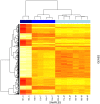RNA sequencing of the human milk fat layer transcriptome reveals distinct gene expression profiles at three stages of lactation
- PMID: 23861770
- PMCID: PMC3702532
- DOI: 10.1371/journal.pone.0067531
RNA sequencing of the human milk fat layer transcriptome reveals distinct gene expression profiles at three stages of lactation
Abstract
Aware of the important benefits of human milk, most U.S. women initiate breastfeeding but difficulties with milk supply lead some to quit earlier than intended. Yet, the contribution of maternal physiology to lactation difficulties remains poorly understood. Human milk fat globules, by enveloping cell contents during their secretion into milk, are a rich source of mammary cell RNA. Here, we pair this non-invasive mRNA source with RNA-sequencing to probe the milk fat layer transcriptome during three stages of lactation: colostral, transitional, and mature milk production. The resulting transcriptomes paint an exquisite portrait of human lactation. The resulting transcriptional profiles cluster not by postpartum day, but by milk Na:K ratio, indicating that women sampled during similar postpartum time frames could be at markedly different stages of gene expression. Each stage of lactation is characterized by a dynamic range (10(5)-fold) in transcript abundances not previously observed with microarray technology. We discovered that transcripts for isoferritins and cathepsins are strikingly abundant during colostrum production, highlighting the potential importance of these proteins for neonatal health. Two transcripts, encoding β-casein (CSN2) and α-lactalbumin (LALBA), make up 45% of the total pool of mRNA in mature lactation. Genes significantly expressed across all stages of lactation are associated with making, modifying, transporting, and packaging milk proteins. Stage-specific transcripts are associated with immune defense during the colostral stage, up-regulation of the machinery needed for milk protein synthesis during the transitional stage, and the production of lipids during mature lactation. We observed strong modulation of key genes involved in lactose synthesis and insulin signaling. In particular, protein tyrosine phosphatase, receptor type, F (PTPRF) may serve as a biomarker linking insulin resistance with insufficient milk supply. This study provides the methodology and reference data set to enable future targeted research on the physiological contributors of sub-optimal lactation in humans.
Conflict of interest statement
Figures









References
-
- Ip S, Chung M, Raman G, Chew P, Magula N, et al. (2007) Breastfeeding and maternal and infant health outcomes in developed countries. Agency for Healthcare Research and Quality. - PubMed
-
- Hauck FR, Thompson JM, Tanabe KO, Moon RY, Vennemann MM (2011) Breastfeeding and reduced risk of sudden infant death syndrome: a meta-analysis. Pediatrics 128: 103–110. - PubMed
-
- Gunderson EP, Jacobs DR Jr, Chiang V, Lewis CE, Feng J, et al. (2010) Duration of lactation and incidence of the metabolic syndrome in women of reproductive age according to gestational diabetes mellitus status: a 20-Year prospective study in CARDIA (Coronary Artery Risk Development in Young Adults). Diabetes 59: 495–504. - PMC - PubMed
-
- US Department of Health and Human Services (2011) The Surgeon General’s Call to Action to Support Breastfeeding. Washington, DC: Office of the Surgeon General.
-
- Institute of Medicine Committee on Obesity Prevention Policies for Young Children (2011) Early Childhood Obesity Prevention Policies: Goals, Recommendations, and Potential Actions. Washington, D.C.: Institute of Medicine.
Publication types
MeSH terms
Substances
Grants and funding
LinkOut - more resources
Full Text Sources
Other Literature Sources
Medical
Molecular Biology Databases
Miscellaneous

